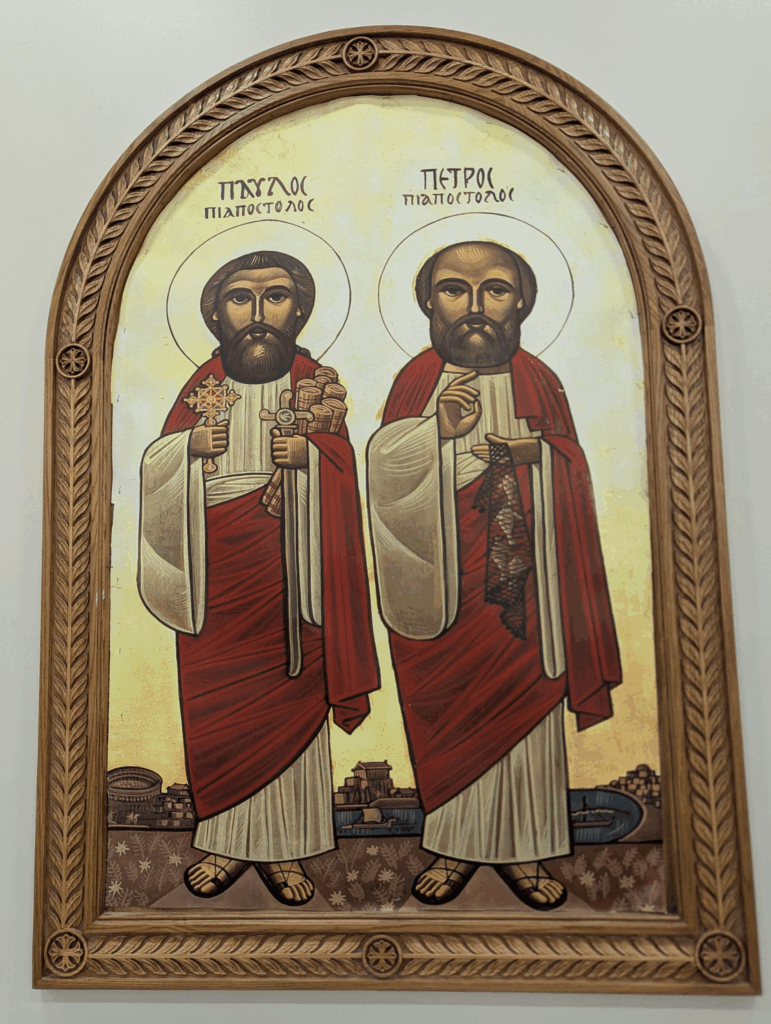
Overview
St. Peter, a fisherman from Bethsaida, was one of the first disciples chosen by Christ and known for his fervent faith—he boldly declared Jesus as “the Son of the living God” (Matthew After receiving the Holy Spirit, he preached the Gospel with power and worked many miracles. He was eventually crucified in Rome under Nero, requesting to be crucified upside down out of humility.
St. Paul, born in Tarsus, was a devout Pharisee who once persecuted Christians. On his way to Damascus, he encountered a divine vision of Christ, was converted, baptized, and filled with the Holy Spirit. He became one of the most influential apostles, spreading the Gospel across the world and enduring great sufferings. He was eventually beheaded in Rome in 67 A.D.
St. Peter and St. Paul are shown together in icons as pillars of the early Church and martyrs under Roman Emperor Nero. Peter is depicted with a fishing net, symbolizing his call to be a fisher of men, while Paul is honored for contributing much of the New Testament.
Full Description
Peter was from Bethsaida and worked as a fisherman. The Lord chose him on the day after His baptism, following the calling of his brother Andrew. Peter was known for his fervent faith and zeal. When Jesus asked His disciples, “Who do men say that I am?” they answered, “Some say John the Baptist, some Elijah, and others Jeremiah or one of the prophets.” But Peter boldly declared, “You are the Christ, the Son of the living God.” (Matthew 16:13–20)
After receiving the Holy Spirit, Peter traveled widely, preaching the message of Christ crucified. Through his hands, God worked many signs and wonders, and many were converted to the faith. He wrote two catholic epistles addressed to the believers. Eventually, he reached Rome and met the Apostle Paul. Through their joint preaching, many Romans believed. Enraged, Emperor Nero arrested Peter and ordered him to be crucified. Out of humility, Peter requested to be crucified upside down, and he gave up his spirit to the Lord.
As for Paul, he was born in Tarsus two years before Christ’s birth. He was a devout Jew from the tribe of Benjamin, raised as a Pharisee and zealous for the Law. Paul, originally named Saul, persecuted the early Church and was present at the stoning of St. Stephen. He later obtained letters from the high priest Caiaphas to arrest Christians in Damascus. On his journey there, a heavenly light shone around him, and he heard a voice saying, “Saul, Saul, why are you persecuting Me?” (Acts 9:4) The Lord identified Himself as Jesus and instructed him to go to Ananias in Damascus, who baptized him. Saul’s sight was restored, and he was filled with the Holy Spirit.
After his conversion, Paul preached Christ with great boldness, enduring many hardships, including imprisonment and beatings. He traveled widely to spread the Gospel and wrote fourteen epistles. When he arrived in Rome, many believed through his preaching, including a young noblewoman related to Nero. Paul wrote the Epistle to the Romans before being arrested by Nero, who had him tortured and sentenced to death by beheading.
As Paul was led to his execution, the young Christian woman wept beside him. He comforted her and asked for her veil to wrap around his head. After the execution, she met the soldier returning from the site, and he confirmed Paul’s death. But she responded, “You are lying, for I just saw Peter and Paul dressed as kings with crowns on their heads, and they gave me back my veil.” She showed it to the soldier, and all who heard this miracle were amazed and believed in Christ.
Through Peter and Paul, God performed many mighty works. People brought the sick into the streets so that Peter’s shadow might fall on them and heal them (Acts 5:15). Handkerchiefs and aprons from Paul’s body healed diseases and cast out evil spirits (Acts 19:12).
Interesting Fact
St. Paul holds a sword, symbolizing both the “sword of the Spirit” (Ephesians 6:17) he describes as a part of “the armor of God” in the book of Ephesians, and his martyrdom by beheading.
St. Peter holds a net, reflecting his past as a fisherman and his apostolic role as a “fisher of men” (Matthew 4:19).
Citations
CopticChurch.net. “Commemorations for Abib 5.” CopticChurch.net, https://www.copticchurch.net/synaxarium/11_5.html. Accessed 16 May 2025.
Sedmakova, Renata. “Why is St. Paul depicted carrying a sword?” Aleteia, https://aleteia.org/2018/10/03/why-is-st-paul-depicted-carrying-a-sword. Accessed 16 May 2025.